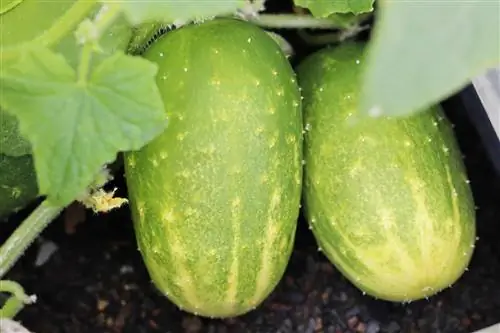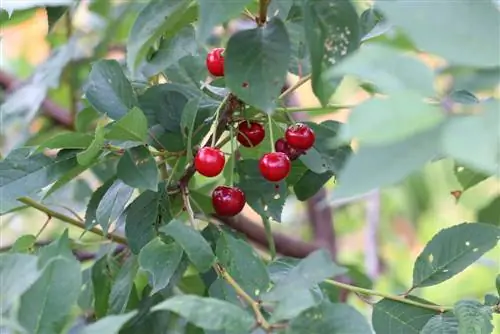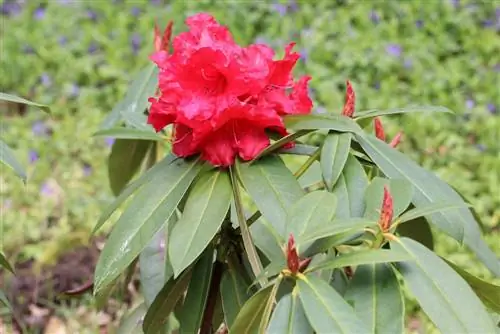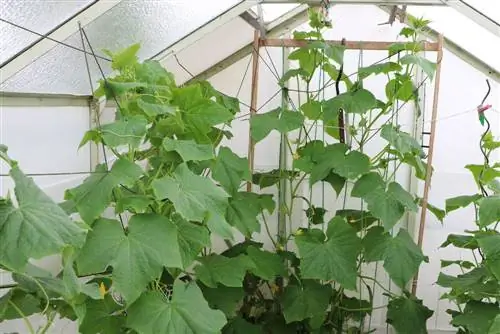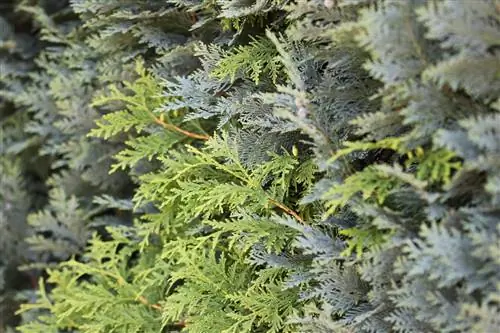- Author admin [email protected].
- Public 2023-12-17 03:39.
- Last modified 2025-06-01 06:48.
The cucumber contains 97% water and only a few vitamins and minerals, but despite everything, the cucumber is a very popular salad fruit in summer. New varieties are continually appearing on the market. For example, very long, smooth-skinned Japanese varieties, which require a particularly mild climate and a supporting structure made of wires. The somewhat delicate apple-shaped and pale green cucumber varieties with their juicy flesh are only suitable for outdoor use in mild areas. As a rule, two different types of cucumber can be distinguished: the outdoor cucumber and the salad cucumber. The outdoor cucumbers are slightly smaller and often have warty skins. These are particularly suitable when harvested young for pickling as pickles or mustard cucumbers. The cucumber is also called the greenhouse or string cucumber; it usually reaches a length of 40 - 50 cm. They are straight, cylindrical and smooth-skinned.
Outdoor cucumber
The outdoor cucumber has no special climate requirements, which is why it is suitable for outdoor cultivation in most areas in Central Europe.
Soil preparation
The cucumber prefers a warm, sunny location and well-drained and nutrient-rich soil. The planting site should be prepared about 1 - 2 weeks before planting the young plants. First, holes about 30x30cm in size are dug at intervals of 60 - 90cm per plant. These are filled with well-seasoned garden compost and filled with fine, crumbly soil. Rotted stable manure has proven itself to be a nutrient-rich organic fertilizer in the growing phase.
Young plants
Two to three seeds are placed about 12mm deep in 8cm high soil press pots with growing medium in mid-spring. The whole thing is then germinated on the windowsill at around 20 degrees. After the first cotyledons have developed, only the strongest seedling remains in the pot. As soon as the seedlings have become too large for the seed pot, they are transplanted into 12cm pots. From April onwards, the plants are slowly hardened off so that they can then be planted outdoors in mid-May. It is very important that the roots down to the lowest leaves are completely covered with a layer of good soil.
Sowing
Sowing directly outdoors only makes sense in really mild areas. Depending on the climate, you can sow seeds there from around the beginning of June. The sowing depth is then about 3cm and the distance between the seeds is 8cm. However, about 3-4 seeds should be placed in each planting hole. It is best to cover the sowing with foil to avoid damage from night frosts. Even when sowing outdoors, only the strongest seedlings are kept.
Care
Always ensure adequate watering around the plant. Regular mulching, especially with manure, supports the growth of the plant. Once five or six leaves have formed, pinch off the tips of each plant to encourage the growth of side shoots. If no fruit sets are visible on the side shoots after the fifth or sixth leaf, then the shoot tips are cut off. If the fruits begin to swell, they should be placed on a layer of straw or foil to protect them from soil moisture.
Harvesting and storage
The ripe cucumber is cut off at the stalk. After harvesting, the fruits can be stored in a cool place for a few days without losing their taste. Outdoor cucumbers must not become too large, otherwise they will lose their aroma. They should be harvested before they turn yellow.
Pests and diseases
The black bean aphid is particularly dangerous for cucumbers because it can transmit viral diseases. Promotion of beneficial insects and insect nets help with prevention. If infested, the plant should be sprayed with a strong jet of water.
variety selection
Chinese Snake=very robust and early variety with a very high yield; up to 50cm long and slender, dark green fruits
Hoffmann's Giganta=very long, dark green, cylindrical fruits, which can be used very well as salad or mustard cucumbers.
Usage
harvested young for pickling as pickles or mustard cucumbers
cucumber
The cucumber is primarily suitable for cultivation in a heated or unheated cold frame. As originally tropical plants, they primarily value high humidity, which is ensured by frequent spraying. As a rule, lukewarm water should be used for this, as cucumbers react very sensitively to cold water.
Greenhouse culture
20 degrees is the optimal germination temperature for all types of cucumbers. With the standard varieties you can gradually lower the temperature a little, but it should never be below 16 degrees at night. At the beginning of May, plant the seeds about 2cm deep in soil press pots, cover them with cultivated soil and place them in a warm place in the cold frame or greenhouse. Once the cucumbers have germinated, wires are stretched horizontally on the greenhouse wall to support the plant and especially the side shoots. Once the seedlings have formed two leaves, they can be placed in a prepared bed. A stick should be placed next to each plant. A constant temperature of 16 degrees must be maintained. The tips of the main shoots must be pinched off as soon as the plants have reached a height of 2 meters or when they touch the greenhouse roof. This promotes the formation of side shoots, which can then be attached to the taut wires with binding threads. However, if there are no signs of fruit on the side shoots that are around 60cm long, these shoot tips can also be cut off. The cucumber plant does not tolerate direct sunlight. Therefore, a partially shaded location should also be chosen in the greenhouse. The plants should be watered regularly and abundantly. Misting increases humidity. While the fruits are ripening, garden compost or manure should be raked in every 14 days.
Growing cucumbers in the cold frame
The planting site is prepared a few weeks before planting. Until germination, the procedure is the same as in greenhouse culture. As soon as the seedlings have formed two leaves, they are placed in soil press pots in the cold frame. Here too, sufficient sun protection must be provided. On warm days, open the window throughout the day. Even in a cold frame you can't do without regular watering and spraying.
Harvesting and storage
In order to get the best taste, the aromatic cucumber is harvested between July and September. To do this, you shouldn't let the fruits grow completely, so you cut the cucumber off when it's about 30cm long.
Pests
On cucumbers that grow under glass, light-colored suction spots on the leaves indicate whiteflies. Therefore, the beneficial insects should be encouraged. Tansy broth or soap preparations help with severe infestations.
variety selection
- Corona=only produces female flowers, suitable for later sowing, also tolerates lower temperatures in the short term
- Bella=purely female flowers, bitter-free, long, slender, dark green fruits, for summer and autumn cultivation.
Usage
mainly for use with raw vegetables or salads.
Profile
- Species/Family: Annual. Belongs to the cucurbit family
- Care effort: High
- Harvest time: July to October
- Foliage: Large, heart-shaped, toothed leaves in dark green
- Growth: Fast growing with prostrate shoots
- Ingredients: Calcium, potassium, magnesium, vitamin C
Location
Most varieties only in the greenhouse. Outdoor varieties are best placed on black mulch film (specialist retailers), as this prematurely and increases the yield
Planting time
Sowing indoors March to May in germ-free seed soil with a depth of 1-2cm. At a soil temperature of at least 22-25 degrees Celsius (even at night) germination in 6-12 days. Plant varieties suitable for outdoor use from mid to late May. Plant spacing 50cm, row spacing 130cm or planting spacing 40cm, row spacing 150cm
Cut
When cultivating in the greenhouse, tie the cords or wires and shorten the main shoot when it reaches the roof. Side shoots are removed after the first leaf and fruit set. No cutting necessary outdoors but possible
Partner
Bush beans, dill, peas, fennel, garlic, cabbage, lettuce, beetroot, celery, runner beans, onions. Form a classic trio with peas and lettuce
Doesn't get along:
Radish, radish, tomatoes
Care
Remove leaves growing close to the ground (up to approx. 20-30cm from the ground) regularly.
Do not wet the leaves when watering, otherwise fungi can quickly colonize
Wintering:
Annual
Diseases
- Powdery mildew: White wipeable coating on the top of the leaf; Plant dies. Cut off affected shoots. If the infestation is severe, use spray (follow dosage instructions). A plant strengthening agent can be used as a preventive measure.
- Cucumber scabies: Syringes (remedies are commercially available)
- Cucumber wilt: Graft on fig leaf cactus
Varieties (selection)
- `Hazan: Mini cucumber. Particularly suitable for the balcony
- `Highmark 2: Mini cucumber.
- `Mertus F1 Hybride RZ: mini cucumber. Improved breeding of 'Hayat. From July to October, 16-18cm long, dark green, shiny fruits with bitter-free fresh pulp. Very profitable. Purely female flowers, therefore regular yield. Considered robust and resistant to powdery mildew and cucumber scabies. Can also be grown outdoors
- `Printo F1: Mini cucumber. Robust variety with 15-17cm long fruits
Accumulation especially in outdoor varieties
Previously loosened soil is pulled towards the plant from all sides and a small wall is formed in which the cucumber then sits. The plant should already have reached a height of approx. 20cm. The earth wall improves the plant's stability and forms new roots, which increase nutrient and water absorption.

